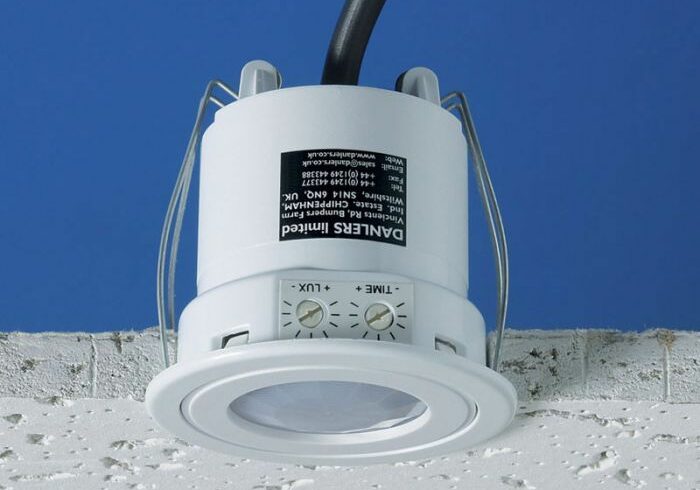The most basic form of lighting controls consist of simple on/off switches built into lamps themselves. That’s fine for such things as table lamps and work lights and in its most advanced form gives us the ability to switch the lamp on or off just by touching the base. The most developed types even provide brightness control.
Then there are the familiar wall-mounted switches, usually placed just inside the doorway controlling lights fixed in various places in a room. Again these can incorporate dimmers to control the level of brightness. For landings and staircases the switches can be two-way so that the light can be switched off or on at the top or at the bottom. For some situations, communal staircases in apartment blocks for example, timer switches provide the simple solution to human forgetfulness. The Electronic Time Delay Switch is a perfect example. When the light is switched on it remains on for long enough for anyone to ascend or descend the stairs and then is automatically switched off. The timing is adjustable to suit the situation.
Activated by changing levels of light is the Flush Mount Photocell Sensor controller. This clever piece of kit is capable of controlling as many different lights as you wish and can be overridden by the normal manual wall switch when required. The level of light is variable by adjustment too.
Another lighting control suitable for controlling multiple lights according to natural light levels is the Dusk To Dawn Photocell. Part of a range of dusk to dawn photo cell controllers, these can control outside security lighting as well as indoor lights.
The next level of sophistication in lighting controls works, not on light level but by detecting movement. If someone is moving about in the dark they must need a light, so the light obligingly switches on and stays on until a pre-determined time after all movement has ceased. This is all made possible by the Passive Infra Red detector, PIR for short.
PIR controllers come in many forms. Some such as the Timeguard 360° PIR Light Switch, can be used to control a number of separate lights from one location. The Light Switch with Movement Detector, is also used to replace the normal light switch and turns an ordinary lighting set-up into an automated system.
For a really unobtrusive PIR system of lighting controls there are small Flush Ceiling PIR Movement Switches. Several of these mounted at intervals of about 5 metres will ensure detection of movement everywhere in the room. These versatile units can be used with lamps of any kind and can even be used to control fans!
These controllers are ideal for use in rooms which are not occupied all the time, such as cloakrooms, so that lights are only on when actually needed. These lighting controls are not only a great convenience but over a year can save a great deal of expensive electricity.
The 360° PIR Light Controller is another one. Cunningly designed to detect movement over 360 degrees it doesn’t matter what the angle of approach, there is no blind spot. The length of time the light stays on when activated can be adjusted to suit the location making them ideal for corridors and staircases that are not in constant use.
Lighting controls then do rather more than take the effort out of flicking switches. They enable lights to come on when you enter a room with both hands full and similarly go out when you leave. Much better than trying to turn the lights off with your chin! They turn on lights when someone enters where they should not, alerting others to the incursion. Whilst performing these useful functions, lighting controls are also saving a fortune in electricity.
Looking for more news, information or inspiration? Try our Lighting Advice section.

Charles Barnett Managing Director
Charles started Lyco in 1995 with just 4 enthusiastic employees and has grown it considerably over the past 25 years. Charles is also the Managing Director of Lighting Direct and newly acquired Online Lighting. He now has a team of 50 lighting experts working on growing Lyco Group to be the UK leader in lighting for both businesses and homes. Away from the office he is a keen cyclist and is proud to have cycled 1017 miles from Lands End to John O’Groats to raise money for a new residential centre for adults with multiple learning difficulties.





